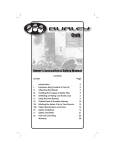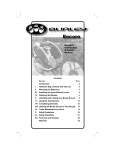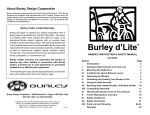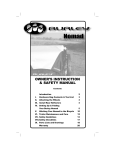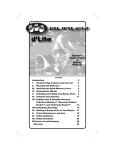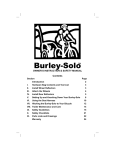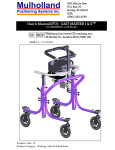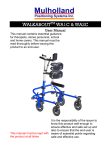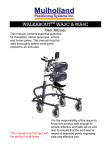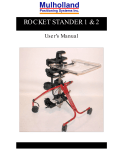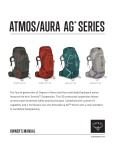Download Burley Cub Owner`s manual
Transcript
About Burley Design Cooperative Burley has been supplying products to the bicycle industry since 1975. Burley products are designed and manufactured at our Eugene, Oregon shop. As worker-owners of our cooperatively owned business, we bring an uncommon degree of personal pride and attention to our work. Use our products with confidence and satisfaction! Burley Trailer Limited Warranty Burley will repair or replace any original equipment parts it determines to be defective for the life of the trailer. The owner of a Burley trailer must present the trailer for repair at an authorized Burley dealer, together with an original sales receipt or similar proof of purchase. This warranty applies only to the original owner and is nontransferable. Burley cannot be responsible for failure due to improper assembly, modification of parts or instructions, neglect, abuse, accident, ultraviolet degradation and/or normal wear. The warranty does not cover any trailers used for rental, competition, or commercial use. Burley neither assumes nor authorizes any person to assume any other liability in connection with Burley trailers, and there are no oral agreements or warranties collateral to or affecting this agreement. This warranty gives you specific legal rights and you may also have other rights which vary from state to state. Burley Design Cooperative • 4020 Stewart Rd. • Eugene, OR 97402 USA (541) 687-1644 • Fax (541) 687-0436 Copyright © 2000-2002 by Burley Design Cooperative • www.burley.com “Burley” is a registered trademark of Burley Design Cooperative and “Burley-Cub” is a trademark of Burley Design Cooperative Printed on recycled paper rev 8/02 Burley-Cub TM Owner’s Instruction & Safety Manual Contents Section Introduction I. Hardware Bag Contents & Tool List II. Attaching the Wheels III. Installing the Tongue & Safety Flag IV. Unfolding & Folding Your Burley-Cub V. Using the Seat Harness VI. Covers VII. Hitching the Burley-Cub to Your Bicycle VIII. Trailer Maintenance & Care IX. Safety Guidelines X. Safety Checklists XI. Parts List & Drawing Warranty Page 2 3 3 5 6 8 9 10 12 14 20 22 24 Congratulations! You’ve just purchased a Burley® trailer, the leading choice of discriminating bicycle trailer owners worldwide. Every effort has been made to ensure your purchase is of top quality and proven design, ready to provide you with many years and miles of happy, safe trailering. IMPORTANT: Because some of the features and guidelines for using the Burley-Cub merit close attention, it is very important that you familiarize yourself with the trailer by reading this entire manual before use. If you have any questions, we encourage you to contact your authorized Burley dealer. Introduction Your Burley-Cub is shipped almost completely assembled from the factory. This manual is written sequentially to assist initial setup. You need only to install the quick-release levers, mount the reflectors, attach the wheels, unfold the trailer, install the safety flag and snap on the cover. Once you've read the safety guidelines, you're ready to go. Before trailering, be sure you have a thorough understanding of the safety harness and of trailer hitch operation. Practice folding and unfolding your trailer; it can easily be done in less than a minute after practice, no tools required. Check to see that the trailer wheels and hitch are securely attached. We again request that you read this manual from start to finish before use, and then refer to it as necessary in the future. NOTE: Any reference to left or right is made in the direction of travel, as if you were sitting in the child seat looking forward. When Loaning or Selling Your Trailer If you loan or sell your Burley-Cub, supply the new user with this manual. They must familiarize themselves with all sections— especially sections “X. Safety Guidelines” and “XI. Safety Checklists” prior to use. It is essential that they understand the differences between riding a bicycle with a trailer and without one. It is also essential that they understand correct wheel attachment, folding, and use of the harness, safety flag, cover, and hitch. Always ensure that both adult and children are wearing helmets. Never loan your trailer if it is need of maintenance or repair. 2 Your serial number is located on the bottom of the axle assembly. Please have your serial number ready when requesting replacement parts. 23 XI. Parts List & Drawing Note: Subassemblies are indented; inquire for additional parts 1. 2. 3. 4. 5. 6. 7. 8. 9. 10. 11. 12. 13. 14. 15. 16. 17. 18. 19. 20. 21. 22. 23. 24. 25. 26. 27. 28. 29. 30. 31. 32. 33. 34. 35. 36. (1) Polyethylene Shell (2) Front Reflector (Clear) (2) Rear Reflector (Red) (2) Suspension Elastomer (1) Pair Side Panel Hold Down (Left & Right) (1) Tongue Retaining Pin (1) Pair Tongue Receptacle (Front & Rear) (1) Safety Pin & Tether (1) Front Roll Bar, 7/8" Aluminum Tube (1) Roll-Bar Handle Assembly (2) Front Roll-Bar Hinge (Plastic) (1) Rear Roll Bar, 7/8" Aluminum Tube (2) Rear Roll-Bar Hinge (Plastic) (2) Roll-Bar Saddle (Plastic) (1) Tongue & Hitch Assembly (1) Tongue, 1 1/8" Square Aluminum (1) Hitch with Hitch Knob & Ball (1) Hitch Safety Strap (1) Clip & D-Ring (1) Rubber Flex Connector (Not Available Without Hitch) (1) Pair Fabric Side-Panel Assembly, with Vinyl Windows (1) Seat Pad (1) Hold Down Strip, Seat Back & Pad (1) Flow-Thru Seat Back with Harness (4) Shoulder Strap (3) Crotch Strap (1) Lap Belt (1) Buckle for Lap Belt (2) Plastic Wheel, Each with (2) Wheel Bearing (2) Wheel Reflector (Clear) with Self-Tapping Screw (1) Swing Arm Assembly (2) Hollow Axle (2) Wheel Axle Assembly (2) Quick-Release Lever (1) Two-Piece Safety Flag (1) Wide Screen 2-in-1 Cover Options (at additional cost): Walk ’n Roller Stroller Kit (not shown) Alloy-Wheel Option I. Hardware Bag Contents & Tool List IMPORTANT: Please verify that you have received all of the contents listed. Do not proceed with assembly if any parts are missing; contact Burley immediately for replacement parts. HARDWARE BAG CONTENTS Parts (1) Tongue & hitch assembly (2) Wheel (1) Two-piece safety flag Envelope Trailer checklist (outside of envelope) Warranty card Burley-Cub Owner’s Instruction & Safety Manual Remove the wheels, tongue and hitch, safety flag, and envelope from the inside of your Burley-Cub. Try to do all initial assembly with the trailer on a clean sturdy table or work bench to make handling the trailer easiest and to keep the fabric clean. If you must work on a rough or dirty surface instead, be sure to lay down a cloth or the flattened shipping carton to avoid damage to the trailer. II. Attaching the Wheels First, verify that the tires are inflated to 30-35 P.S.I. Next, tip the trailer frame on its back end. If you are working on a rough or dirty surface, lay down a cloth or other protective barrier to avoid damage to your trailer. With the quick-release lever in the "OPEN" position, insert the wheel axle assembly completely into the hollow trailer axle, making sure that the horizontal shaft goes all the way into the axle. Quick-release lever in unlocked "OPEN" position Quick-release lever in locked "CLOSED" position Wheel axle assembly inserts into hollow trailer axle 22 3 "OPEN" position "CLOSED" position Once the wheels are fully seated in the hollow axle, the quick-release lever should be positioned so that it is aimed to the rear of the trailer in the "CLOSED" position. (The lever is marked for OPEN or CLOSED positions.) The wheel quick-release/ axle assembly comes preadjusted from Burley. NOTE: All wheels, including optional spoked alloy wheels, must be mounted with the recessed side of the hub facing inward. Make sure wheels are held securely, with wheel shaft fully inserted into the hollow axle. You should not be able to rock or shift wheels. Improperly installed wheels can fall off, causing accident and serious injury. With wheels mounted, both reflectors must face outward. Check to see that both reflectors have been installed correctly. Incorrectly installed reflectors can reduce trailer visibility at night and cause accident and serious injury. 4 21 X. Safety Checklists Before Each Ride, Ensure the Following: √ √ √ √ √ √ √ √ √ Wheels tightly attached Tire pressure 30–35 P.S.I. Hitch properly secured with safety strap in place Roll bars locked together Locked retaining pin for tongue Maximum load 100 lbs. Bicycle safety check, especially brakes and tires Helmets for children & rider Safety flag in place Monthly Checklist √ √ √ √ √ √ √ √ √ √ Inspect the tongue and hitch for damage, scratches, or loose fasteners Inspect roll bar and handle for smooth operation; lubricate with spray or drip lubricant as needed Inspect polyethylene shell for cracks, damage, or loose parts; pay close attention to tongue and axle mounting points Inspect tires; worn out or cracked tires can lead to blowout Inspect wheels for trueness and cracks Inspect wheel bearings for wear Inspect wheel latches for smooth operation; lubricate with spray or drip lubricant as needed Inspect axle for damage Inspect fabric canopy, child seat, and harness for rips, abrasion, or missing/damaged hardware Repair or replace any damaged or worn-out parts IMPORTANT: Refer to section “VIII. Trailer Maintenance & Care” of this manual for additional periodic maintenance. Unless you are a qualified bicycle mechanic, contact your Burley dealer for repairs and maintenance. III. Installing the Tongue & Safety Flag Installing the Tongue The tongue attaches to the left side of the trailer. When installed, the tongue bends to the right, which places the hitch near the center line of the trailer. Slide the tongue through the two plastic tongue receptacles until the end of the tongue is flush with the back edge of the rear tongue receptacle. Retaining Pin Safety Pin Secure the tongue as follows: 1. Slide the retaining pin in the rearward receptacle Forward Hole in Tongue through the hole provided in the tongue. 2. Secure and lock the pin by 2 rotating it toward the rear of the trailer as shown in 1 the drawing. 3 3. Slip the safety pin through the forward hole in the tongue and lock in place. Refer to the illustration showing the locked position of the safety pin. Firmly pull on the tongue to ensure that it is secure. Safety Pin in Open and Locked Positions Open Locked Tongue retaining pin must be locked into place before using trailer. If pin is not properly locked, trailer could separate from bicycle, resulting in accident and serious injury or death. Safety pin is a backup for the retaining pin. Under no circumstances should the trailer be towed with only the safety pin engaged. 20 5 Installing the Safety Flag Observe Age and Height Restrictions The safety flag pole fits at the left rear corner of the trailer. Thread it through the vertical casing of the side panel on the outside of the rear roll bar, and slide it down until it rests on the floor of the cargo area. The trailer seat is intended only for children old enough to wear a helmet and sit upright alone. Your child must have adequate neck strength to hold his or her head up while trailering. Check with your pediatrician if you are unsure about your child’s ability to sit upright and hold his or her head up. Never carry a child whose sitting height (with helmet) is above the roll bar, because their chance of injury is significantly higher in the event of tip over. Follow the Rules of the Road Slide flag pole through casing until it rests on floor. IV. Unfolding & Folding Your Burley-Cub Unfolding Your Burley-Cub Bicycles are vehicles, and are required to observe all rules of the road. Always signal turns and stops; ride with both hands on the handlebars except when signalling. Scan ahead for dangerous situations, and anticipate turning traffic. Watch out for parked cars and opening doors. Never run stop signals, and never ride against oncoming traffic. On bike paths, give audible warning when passing pedestrians from behind. If you are not aware of your local and state bicycle regulations, contact your nearby police or motor-vehicles office for more information. Refer to the owner’s manual of your lead bicycle for safe cycling information. Have Fun Defensively Your Burley-Cub is designed with a durable polyethylene bucket, lightweight aluminum frame with roll cage, and bright-colored nylon software. Setting it up or folding it down is accomplished ina few easy steps as follows. Place the trailer on its wheels. To raise the roll bars, first open the roll bar handle as shown in the drawing below. Raise front & rear roll bars. Besides being practical and easy-to-use, the Burley-Cub allows people and children to get outdoors for some fun together, rain or shine. The fact that you’re getting exercise and fresh air at the same time is an added benefit! So, whether you’re going down to the corner store, across town on a picnic, or off for an extended vacation, enjoy your Burley-Cub and remember . . . ALWAYS RIDE DEFENSIVELY! Nestle the front roll bar into plastic saddles on the rear roll bar and engage the handle into the brass spool. If needed, jiggle the handle to ensure it’s engaged. Close and lock the handle into place as shown. Open 6 Closed 19 Wear Helmets Numerous studies have shown that: • Head injury is the leading cause of bicycling fatalities; and, • Helmets prevent or reduce bicyclists’ head injuries. For safety, it is essential that both cyclist and passengers use approved bicycling helmets at all times. Don’t take chances. Do not use trailer unless front and rear roll bars are locked together and roll bar handle is closed. An open handle could cause roll bars to collapse, resulting in an unsafe condition. Proper Wheels and Tires are Essential Folding Your Burley-Cub Use only the factory-supplied wheels, and keep them properly maintained. Inflate tires to 30–35 P.S.I. and check pressure before each use. Do not use higher-pressure tires, as the trailer will be bouncy and prone to tip over with light loads. We only recommend tires with street tread. Do not use all-terrain type tires. Folding your Burley-Cub is basically the reverse of the unfolding procedure. To fold your trailer: 1. Remove the cover if already installed. Know Your Trailer Hitch 2. Remove the safety flag. Clamp the hitch securely to the bicycle frame, and check for a tight attachment each time you use the trailer. Refer to sections “VII. Hitching the Burley-Cub to Your Bicycle” and “VIII. Trailer Maintenance & Care” of this manual for proper installation, use and maintenance of your hitch. 3. Tilt the trailer onto its rear edge. Use Your Flag Always use the safety flag—it’s an essential safety device. The moving flag will help make you more visible to motorists and other cyclists. 4. Remove the wheels. 5. Remove the tongue by unlocking the retaining pin (rotate it toward the front of the trailer), then raise it out of the hole in the tongue. Remove the safety pin. Next slide the tongue forward out of the tongue receptacles. IMPORTANT: The tongue retaining pin is captured between the tongue receptacle and the lip of the poly shell. It should never be completely removed from the tongue receptacle. Protect Your Child When pulling a child, use the shoulder harness, lap belt, and child helmet at all times. Always fasten the seat belt so that each child is held securely. For maximum stability and safety, seat a single child in the center of the trailer. Periodically check placement of shoulder straps, especially for a sleeping child. Check that a child cannot put a finger into the wheel spokes. Be aware that children get thirsty when riding in the trailer. Bring plenty of water, especially on longer rides; keep a full water bottle in the trailer where your children can easily quench their thirst when they desire. 6. Open the roll bar handle and disengage the front and rear roll bars. Lower the rear roll bar into the poly shell. The front roll bar will rest on the rear lip of the trailer. You can partially fold your Burley-Cub as needed. Your options are: a) to fold only the roll bars, b) to remove the tongue and hitch, c) to remove the wheels, or d) any combination of the above. Do not operate your Burley-Cub in a partially folded condition. 18 7 V. Using the Seat Harness of control: have the children get out of the trailer and disconnect it from the bike; carefully roll your trailer and bike, independently, up or down the stairs. Never take your bike or trailer on escalators. IMPORTANT: Only passengers who are able to wear a helmet and sit upright, unassisted should ride in a trailer. Adequate neck strength is required to hold head upright while trailering. A physician should evaluate anyone who is of questionnable developmental age for trailering. Use Cautiously with Pets Crotch strap O-ring must be positioned at child’s sternum to work correctly. An O-ring positioned near child’s neck can cause discomfort or serious injury. Check child periodically to ensure he/she is seated correctly. Thread each shoulder strap through the back of each O-ring located on the crotch strap and connect buckle (A) at opposite shoulder. Tighten as necessary. Adjust the crotch strap (B) so the O-ring is at the child’s sternum. Be sure to connect and tighten the lap belt (C) after connecting the shoulder straps. Single Passenger: Seat single child in center of seat and use right side shoulder strap and center crotch strap. Fasten shoulder harness to buckle at shoulder ( ). Adjust and tighten at arrows ( ). Crotch strap O-ring must meet at child’s sternum. Unhook seat divider strap from snap hook at front of trailer. Two Passengers: For two children, use both shoulder harnesses and two outer crotch straps. Fasten shoulder harnesses to buckles at shoulder ( ). Adjust and tighten at arrows ( ). Crotch strap O-ring must meet at child’s sternum. Your trailer is not designed to secure pets. A cat or other small pet can be towed if they are in a pet carrier secured to the trailer frame. A sedate dog can be towed seated on the trailer floor: add carpet for comfort, always use a cover, and do not exceed 100 lbs. Never tow an excitable dog in your trailer, as it may lunge or try to jump out causing tip over or other accident. Avoid Riding at Night Make every effort to schedule your rides so you are not pulling a trailer at night. Because your vehicle is longer and heavier you will be less able to react to unseen hazards. Automobile drivers may not be accustomed to your longer vehicle and may not react to it appropriately. If you must ride at night, wear bright, reflective clothing, use a bright headlight and a red blinking taillight on your bike. Similarly, put a red blinking light in the light-holder tab sewn onto the back of your cover so you can be more easily seen. Do not operate without properly attached reflectors; replace cracked or missing reflectors. Always Use Your Cover Affix your Wide Screen 2-in-1 Cover™ to protect your child from flying debris when pulling your trailer. Never leave a child unattended in direct sunlight because heat buildup in the trailer can cause serious harm. Open or close the vinyl cover, depending on the weather, to help keep your child cooler or warmer. Check periodically to ensure that they are comfortable. Cool Weather Use When the temperature is 60-70˚ or colder you may be comfortable without heavy clothing because your pedaling effort helps keep you warm. However, when you consider the child’s inactivity sitting in the trailer—coupled with a potential windchill factor—an extra sweater or jacket may be needed for them to keep from getting too cold. Hook seat divider strap to snap hook at front of trailer. 8 17 No Motorized Vehicles Your Burley-Cub is only intended for use with pedal-powered cycles; never pull it with a motorized vehicle, as the increased acceleration and speed could damage the trailer or cause the trailer to tip over. Child and cyclist must wear helmets when trailering. Helmets can prevent or significantly reduce head injury in event of accident. Avoid Riding in Traffic We recommend against riding in traffic. If you must ride in traffic, do not pull your trailer on highways, busy streets, or on streets unsafe for bicycling with children. Never assume that you will be given the right-of-way, even if it is legally yours. Your child is a precious load; his or her safety should not be entrusted to a car driver whose attention or regard for bike riders is unknown. Use care when pulling your trailer on bike routes or along bike lanes, especially at intersections. The straps and sliding buckles sewn to the back rest of the child seat are part of a self-adjusting system that keeps the shoulder straps at the correct height for children of various sizes. When you tighten the shoulder harness, the sliding buckles allow the shoulder belts to come across the top of the child’s shoulders, creating a snug fit. At the same time, the sliding buckles keep the straps from falling off of the shoulders. Ride on Clean, Paved Surfaces VI. Covers Your Burley-Cub is not intended for off-road use. Towing a child off road can be especially dangerous. Any bumps or irregularities could cause tip over and serious injury to the bicyclist or passenger, or damage to the trailer. Your Wide Screen 2-in-1 Cover™ is held in place by six snaps at the front, rear, and top. Note that the Burley logo faces the rear. Cross over railroad tracks, curb cutouts, and road grooves at 90˚. Riding parallel or at acute angle to such obstacles can cause a crash, resulting in serious injury. Riding When It’s Slippery Be especially careful in wet, rainy, or freezing conditions. Your ability to control and stop your bicycle when towing a trailer is greatly impaired. In wet conditions apply your brakes periodically to be sure the rims and brake pads are clear of water. Avoid forceful braking which can cause dangerous skidding. Ride slowly and allow a greater margin of safety when starting, stopping, and turning. Do not ride on surfaces where sand, gravel, ice, oil, or other slippery substances are present. If you must pass over slippery surfaces, walk your bike and trailer. The Wide Screen 2-in-1 Cover™ features a clear plastic flap in front. To install, snap the mesh portion to the roll bars, then fasten the rain flaps to the mesh portion. When attaching the cover always start by fastening the snaps at the top of the roll bar. Next attach the front left snap (the one closest to the tongue). Before snapping the right front snap, tuck the front edge of the cover under the lip of the shell. Likewise, after fastening one of the rear snaps, tuck the rear edge of the cover below the lip of the shell, then fasten the other rear snap. To make your trailer more visible, clip a light into the light-holder tab sewn on the upper part of the back of your cover. There are several brands of inexpensive clip-on lights that will make your trailer more visible to motorists and other cyclists. Always use your cover to keep debris out of (and toys inside) the trailer when it’s in tow. Navigating Curbs, Stairs, and Escalators Never tow your trailer over curbs; rider must dismount and walk over any curbs. If you must traverse stairs, prevent a hazardous loss 16 9 VII. Hitching the Burley-Cub to Your Bicycle The trailer hitch was designed to quickly and safely attach to virtually all types of bicycles. It is inserted in front of the left rear dropout of your bicycle. Hitching the Trailer to Your Bicycle Loosen the knob on the eyebolt until the two arms are spread fully apart. Slip the lower hitch arm under the chain stay (A) and the upper arm above the seat stay (B). Wedge the hitch cone all the way back into the angle formed by the stays at the wheel. Tighten the knob until the arms are firmly clamped against the stays. Wrap the safety strap around the inside of the chain stay, over the hitch body, and back to the D-ring at the end of the tongue. Make sure that the cone is wedged securely into the stays. Do not overtighten the knob. The hitch should not move, but should allow the bicycle complete movement, including lying it down on the ground. It should clear any racks, bags, or fittings you have on your bicycle. If there is any interference, contact your Burley dealer. IMPORTANT: Remove trailer from your bicycle when it’s not in use to prevent deforming the plastic hitch. on bike paths). We recommend you spend some time experimenting with a loaded trailer in an low-traffic area to become familiar with how your heavier, longer vehicle responds. Prevent Trailer Tip Over Just like automobile and motorcycle trailers, bicycle trailers can tip over. To avoid overturning: Do not pull your trailer over curbs or hit holes or other obstructions in the road. Instruct children not to bounce, rock, or lean, which can cause a shift of weight. Do not make high-speed turns or descents when pulling the trailer. Always corner with caution at 5 m.p.h. or less, as the trailer cannot lean into a turn the way a bicycle can. Do not under any circumstances travel faster than 15 m.p.h.—all road irregularities and your slowness to react are greatly magnified. Trailers can tip over causing damage to trailer and serious injury to cyclist or passengers. • • • • • • • AVOID causes of tip over, especially: Children leaning or bouncing Hitting potholes, curbs, other road obstructions Taking turns too fast Sudden swerving Off-camber turns Improper wheel installation Improper tire inflation B Fit, Alert, Adult Pilot To safely pull a trailer, you need to be a fit, experienced cyclist. You must be alert, have good sight and hearing, and adequate strength in your legs, arms, and hands. Never allow a child or adolescent to pull your trailer because it is likely that they lack the necessary physical ability and judgement. A No Headphones or Other Distractions Do not bicycle or stroll with headphones, cell phones, radios, or other distractions. You must be able to hear surrounding traffic, and concentrate on safe bicycling at all times. 10 15 IX. Safety Guidelines Bicycling with a trailer is different from bicycling without one, in ways that aren’t always obvious. It is therefore essential that you read and understand all of the following safety guidelines—in addition to the warnings and instructions in the previous sections— prior to using your trailer. Before loaning your trailer to others, make sure they too understand its proper, safe use. Contact your dealer or Burley if any of these instructions are unclear. Bicycling with a trailer, and bicycling in general, can be hazardous. Failure to observe any of section “IX. Safety Guidelines” could result in accident and serious injury or death. Do not operate trailer without hitch safety strap properly installed. A dangling safety strap can contact spokes and damage rear wheel or cause accident resulting in serious injury. Hitch must seat properly into stays and not interfere with racks, bags, or fittings. Inspect hitch and tongue frequently for damage or loose fasteners. Interfering parts or damaged hitch can cause accident resulting in serious injury. Use Well-Maintained Bicycle and Trailer Use a bicycle that is in good working condition, with good brakes. A frequent safety check of your bicycle is essential. Inspect and maintain your trailer as outlined in section “X. Safety Checklists” of this manual. Have your Burley dealer maintain and inspect your bicycle and trailer if you are not qualified to do so. Loading Your Trailer Do not use or store trailer at temperatures below 32˚ Fahrenheit as hitch rubber flex connector can become brittle and possibly break, causing accident resulting in serious injury. IMPORTANT: Read and study sections “IX. Safety Guidelines,” and “X. Safety Checklists” before using your Burley-Cub. Do not overload the trailer. Maximum trailer load limit for children and/or cargo is 100 lbs. When placing children or cargo into the trailer, keep the load centered or forward of the axle. Pack the load as low as possible and make sure items cannot shift around. Loose, heavy objects can injure passengers in event of a sudden stop or tip over. Starting and Stopping Because of the trailer’s additional weight, a bicycle pulling a trailer will be slower to start up and stop, and because of its length it requires more time to cross streets or paths. Your entire vehicle is heavier and less responsive. This means you should think further ahead in anticipating stops, turns, and starts. Note that your trailer extends out further on the left; allow for this difference when turning, passing pedestrians, or approaching obstacles (like posts 14 11 VIII. Trailer Maintenance & Care Storing Your Burley Cub We build trailers to last, and often see fifteen-year old Burley trailers in use, but even a Burley trailer will not last forever. When not in use, the trailer should be stored out of the sunlight, as extended exposure will cause deterioration to the polyethylene shell, hitch, and fabric. Your polyethylene shell will need to be replaced if it becomes damaged or cracked. Periodically inspect all parts of your BurleyCub using section “X. Safety Checklists.” Hitch and Tongue Maintenance Your trailer is designed for low maintenance and easy care. Clean and grease the eyebolt threads on the hitch periodically to ensure that the eyebolt knob can be properly tightened. Because of ultraviolet degradation, we recommend that the hitch be replaced every five years under normal use. In sunny or smoggy locations, or for trailers that are stored outdoors, the hitch should be replaced every two to three years for safety. Replace your hitch or tongue if there are any signs of damage—i.e., cracks, dents, scratches. Trailer with damaged or ripped fabric components can permit harmful contact between child and spinning spokes or moving pavement, and cause serious injury. Trailer with cracked or damaged shell, hitch, or tongue could fail, causing an accident and resulting in serious injury. Replace damaged components. Lubrication Periodically use a spray or drip lubricant to ensure that the roll bar handle pivots smoothly. Be careful to prevent overspray as the lubricant could soil or damage fabric components. Suspension Elastomer Maintenance Periodically inspect suspension elastomers for wear, cuts, or damage. Should you need them, replacements are available from your authorized Burley dealer and are easily installed. When ordering a replacement hitch, you must specify that your Burley trailer is equipped with a square tongue. Trailers with round tongues require a different hitch. Fabric Care Your Burley-Cub’s fabric is a tough, durable packcloth. The nylon fabric is coated for waterproofness and is highly resistant to fading. The fabric can be easily cleaned with any mild soap or detergent and warm water. For more persistent soil, use a nylon bristle brush. When not in use, store your trailer in a dry, well-ventilated area; wipe it dry before storing to help avoid mildew. Nylon fabric will eventually fade, especially when exposed to direct sunlight. To extend the life of your fabric, as well as the hitch and other components, do not store your trailer in sunlight. Do not use bleach for cleaning, as it will damage the nylon. The nylon fabric is an important part of your trailer’s structure, and provides a safety envelope for child passengers. Replace any nylon fabric that is ripped, scuffed, or otherwise damaged. 12 13












